|
Goal
GPS data from last weekend's field trip need to be brought into
the GIS project constructed in Lab 7 and assembled into a geologic map that shows
field observations.
Procedure:
The general procedure for lab this week involves the following steps:
- Import field data into the ArcGIS project created last week;
- Edit the existing Rocks Unit contacts feature class. Edit your
point file attribute table, if necessary;
- Create a topology and new Rock Unit polygons;
- Symbolize the new data to make a map;
- Hyperlink field photos to locations.
9.1 Getting Started - Importing Field Data
- Download your receiver. To do so:
- Cable the unit to your PC and
turn it on. Doing so will activate the
Windows Mobile Device Center in Windows 7 or 8.
- Browse the unit to find your
ArcPad Nueces River folder; copy this folder to your Lab
9 network storage space or flash drive;
- Disconnect your unit from
your computer and close the Mobile Device Center
software;
- Open your ArcGIS Lab 7
project for the Nueces field trip. This
must be the same project where you created the
ArcPad files.
- "Start Editing" - select the
blank point feature class in your
Nueces_River_2014 geodatabase as the layer to edit;
- On the ArcPad toolbar, click
the icon for "Get Data FROM ArcPad";
- Using the "Add Data" button
(shown as the "Browse button" below), Browse to
your downloaded folder of field data and select
the AXF files that contain your data (or "Select
All"), then Click the "Check in" button;
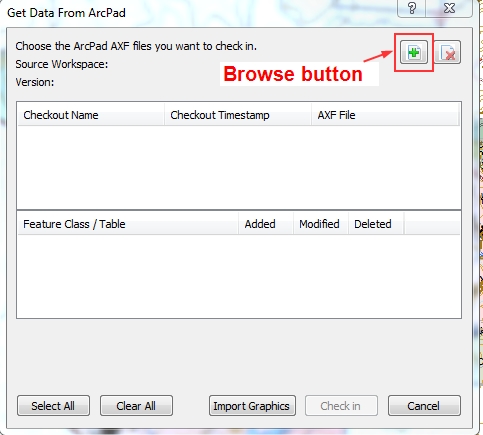
-
If successful, this step updated your
empty point and line feature classes with data
you collected - you should see these features on the
screen.
-
"Save Edits" and "Stop Editing".
-
To download your TrackLog shapefile, use
Windows Explore on the receiver to browse to My Documents>My
ArcPad and drag and drop the 4 or 5 files named TrackLog to
a folder on your storage space. The TrackLog is a
point shapefile. To convert it to a line, search for
and use the Point to Line tool in ArcToolbox.
- To Download PDF Maps data from your
phone (Iphone directions below should be similar to the
process on an Android device):
- With the image
containing your points open in PDF Maps,
select the "Map Features" icon, shown
below at
left, then choose the "Export"
icon at the bottom, shown below at right.
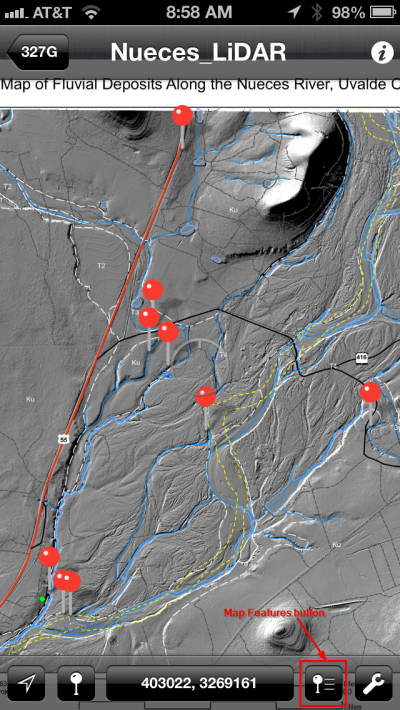

- In the second "Map
Features" window, select "Export Data (KML/GPX)" (below
left) and in the "Export Data" window choose "KML" and a
destination, either your DropBox or an Email attachment
(below right). This will create a Keyhole Markup
Language (KML) file that can be imported into ArcMap or
Google Earth. With more than one Placemark, Line
or Track (and photos, if you choose), a zipped KML file
(known as KMZ) will be created, which is also readable
by both programs. FYI, GPX, the other export
format listed, is a common exchange format for GPS data. We will not use it,
but such files can be imported by many programs and
Apps, including ArcMap. Finally, if you chose to, you could turn off
visibility from some of your data (available through the
blue arrow on the window shown above, right), then
"Export visible data" only (below right).
Regardless of which options you choose, all data will be exported with GCS WGS84
coordinates.
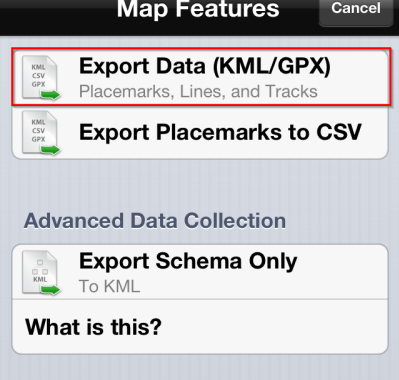
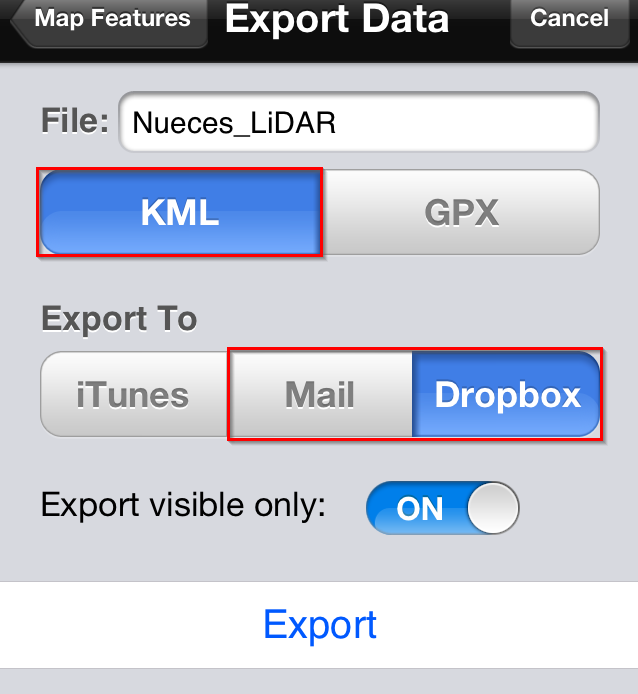
-
Within ArcCatalog, create a folder in your Lab
9 folder
named "NR_field_data_XX", where XX is your initials. Retrieve this newly created KMZ file
from your DropBox or email and copy it to this folder.
-
Move your field digital photos from
your camera or phone to the
same folder.
-
Use the Search tool in ArcMap to find
the ArcToolbox tool "From KML". The "KML
to Layer" tool will convert KML points and/or lines and
attributes (but not photos) to geodatabase feature
classes within a newly created geodatabase and add them
to your ArcMap table of contents.
9.2 Sharing Data
- To share field data with your partner or with others, in ArcCatalog, Browse to the newly updated Point and
Line feature classes in your Nueces_River_2014 geodatabase, right click on one
of them and "Data>Export>To shapefile(mutiple)" to create
two
new shapefiles in your "NR_data_XX" folder. Using the Windows compression utility, create a
zip file of this folder. You can do the same for your
PDF Maps data and photos.
- Upload your zip file to a DropBox site and share it with your partner(s), or copy it to a flash drive
that can be shared, or email it.
- For shared data, load the point and shapefiles, one at a time, examining
the attribute table for each. Delete those that
replicate observations - you only need one point or line
at each site, not many of the same that record the same
thing(s).
9.3 Editing The Geologic Map
- Using what you learned in Lab 4 and 5, edit the
Rock unit contacts feature class to incorporate
your field data. This will involving moving
existing lines and creating new lines. DO NOT
BOTHER WITH EDITING THE POLYGON FILE (i.e. Rocks and
terrace deposits). These will be regenerated
by creating new polygons from the the edited Rock
unit contacts feature class.
- Create a topology, (see Lab
4), from the edited
lines, then create new polygons, and make a field in the
polygon attribute table for unit abbreviation.
- Fill the attribute table with the proper unit
abbreviations (Ku, T1, T2, T3, etc.). Make these
designations on the basis of elevation - T1 is the highest
terrace, T2 next highest, etc. This will require
some guessing for areas we did not visit.
- Symbolize and label the units to complete your
geologic map.
9.4 Hyperlinking field photographs to field
sites
Read the section on "Setting HTML pop-up properties for feature layers"
in ArcGIS Help and create HTML pop-up displays for 3 or more
field photographs of your choosing. These will be set up as
"attachments" on the point feature class (see ArcGIS Help for how to
create and enable attachments). You choose how best to organize
the data! An alternative but less attractive way to do this is to
enable the hyperlink tool using a dynamic hyperlink for each point
feature. Search ArcGIS Help for "Using Hyperlinks", paying
particular attention to the section on "Defining dynamic hyperlinks
though Identify Results". The preferred method for
establishing and viewing hyperlinks is:
-
Rename your photos with meaningful file names so that you can easily
know what they show.
-
We will link photos to the field station points by adding them as
"Attachments" to the points. To add attachments, we first need to
"enable" the point feature class so it can contain attachments. Follow
the two steps in ArcGIS Help "Enabling attachments" to do so.
-
Using the instructions in ArcGIS Help "Adding attachments to
feature", attach your photographs to the points where they belong.
-
Once attached, there are number of ways to view the photos, including
using the Identify tool and the attribute table. Read about these in
ArcGIS Help "Viewing attachments".
-
Neither of these viewing techniques is very elegant - the picture
viewing window often covers the map. We will instead set up HTML
pop-up windows for viewing the photos and attribute information.
Read ArcGIS Help "Setting HTML pop-up properties for feature layers".
We will use the first option mentioned, "As a table of visible fields"
that "Include(s) feature class attachments". Read
carefully these sections and create your pop-ups. It's a lot simpler than it
looks and you'll be pleased with the result. An example is shown
below; Popups are launched using the HTML Popup tool on the Main
Toolbar, highlighted in red below.
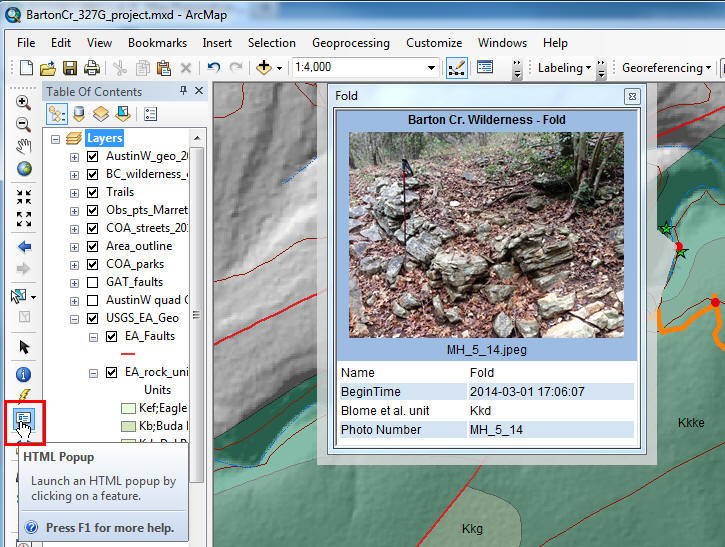
9.5 Create a new map
-
Create a page-size layout of the field trip area containing the
new map elements. Selectively symbolize point features for the
information they contain, using a different color or symbol for the
different point "types". Feel free to add other "types", as
needed, to describe the features observed.
To Turn In:
The layout
described in step 9.5 above, AND a screen capture, like that above, that shows a
photograph attachment open in ArcMap.
You're Done!
|
 |